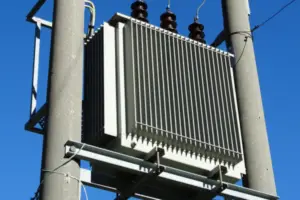Transformers play a vital role in power distribution and electrical systems. They are responsible for stepping up or stepping down voltage levels to ensure that electrical equipment receives the right amount of power.
However, like any other equipment, transformers can fail or deteriorate over time. A failing or bad transformer can cause damage to equipment, pose safety hazards, and result in costly repairs or replacements.
In this article, we will discuss the signs and symptoms of a bad transformer and how to identify them.
Table of Contents
What is a transformer?
Before delving into the signs of a bad transformer, it’s essential to understand what a transformer is and how it works.
A transformer is an electrical device that transfers electrical energy from one circuit to another through electromagnetic induction. It consists of two coils of wire, called the primary and secondary windings, wrapped around a magnetic core.
When an alternating current (AC) flows through the primary winding, it creates a magnetic field that induces an electrical current in the secondary winding.
The transformer’s design determines the voltage ratio between the primary and secondary winding.
Signs of a bad transformer:
The transformer keeps tripping CB or blowing the fuse
A transformer that keeps tripping circuit breakers or blowing fuses is a sign that it is going bad. This issue can be caused by a variety of factors, such as overloading, short circuits, or internal faults within the transformer.
Here are some possible reasons why a transformer keeps tripping CB or blowing the fuse:
- Overloading: If the transformer is overloaded, it may draw too much current and trip the circuit breaker or blow the fuse. This issue can be caused by adding too many loads to the transformer or by a faulty load. Read my comprehensive article about Transformer overloading for more information.
- Short circuits: A short circuit occurs when the current flows through a path of low resistance, bypassing the intended load. This can happen when the insulation between the transformer windings breaks down or when the transformer core becomes magnetically saturated. I recommend reading y article Transformer insulation failure causes. for in-depth information.
- Internal faults: Internal faults within the transformer can cause the winding to short or open circuit, which can trip the circuit breaker or blow the fuse. These faults can be caused by insulation breakdown, overheating, or mechanical stress.
If your transformer keeps tripping circuit breakers or blowing fuses, It’s important not to ignore this issue as it can pose a safety hazard and cause damage to your electrical system.
In some cases, the problem may not be with the transformer itself but with the circuit breaker or fuse.
If the circuit breaker or fuse is old or faulty, it may trip or blow even when the transformer is functioning correctly. In this case, replacing the circuit breaker or fuse may solve the problem.
silica gel breather filled with black oil

If you notice that the silica gel breather of your transformer is filled with black oil, it is an indication that the transformer is going bad. The silica gel breather is a component that helps regulate the air flow in and out of the transformer. It contains silica gel, which absorbs moisture from the air, and changes color when it is saturated.
When the transformer is in good condition, the silica gel breather remains dry and changes color slowly over time. However, if the transformer is going bad, it may release oil and moisture into the silica gel breather, causing it to become saturated, the black oil indicates a bad transformer due to overheating or a short circuit.
Here are some possible reasons why the silica gel breather of your transformer is filled with black oil:
- Overheating: If the transformer is overheating, it can cause the insulation to break down and release oil and moisture into the silica gel breather. Overheating can be caused by a variety of factors, such as overloading, poor ventilation, or faulty cooling systems.
- Contamination: If the transformer is contaminated with dirt, debris, or water, it can release oil and moisture into the silica gel breather, causing it to become saturated. Contamination can be caused by environmental factors, such as flooding or dust storms, or by poor maintenance practices.
- Internal faults: Internal faults within the transformer can cause the insulation to break down and release oil and moisture into the silica gel breather. These faults can be caused by aging, mechanical stress, or electrical stresses, such as short circuits or overvoltage.
Strange noises
Transformers operate silently, so any unusual noises indicate that something is wrong. Buzzing, humming, or vibrating noises can indicate a failing transformer.
These noises are usually caused by loose components, worn bearings, or a damaged core.
Overheating
Transformers generate heat during normal operation, but excessive heat is a sign of a problem. If you notice that the transformer is hot to the touch or emits a burning smell, it could be overheating.
Overheating can be caused by a variety of factors, including overloading, a faulty cooling system, or insulation breakdown.
Read my comprehensive article Signs of transformer overheating and how to prevent it, for more information.
Voltage fluctuations
A bad transformer can cause voltage fluctuations in the electrical system. Fluctuations in voltage can damage equipment or cause lights to flicker or dim.
If you notice these symptoms, it’s important to have the transformer checked by a qualified electrician.
Oil leaks
Transformers use oil as a coolant and insulator. If you notice oil leaking from the transformer, it could indicate a problem.
Oil leaks can be caused by a damaged gasket, a faulty valve, or a cracked tank.
Reduced capacity
A bad transformer may not be able to handle its rated capacity. If you notice that the transformer is struggling to keep up with demand or that it’s frequently tripping circuit breakers, it could be a sign that the transformer is going bad.
How to identify a bad transformer:
To identify a bad transformer, you need to perform a visual inspection and conduct some basic tests. Here’s how:
Visual inspection
Inspect the transformer for signs of damage or wear, such as cracks, dents, or corrosion. Look for oil leaks or discoloration. Check the cooling system for any blockages or obstructions.
Voltage tests
Use a multimeter to test the voltage output of the transformer. Compare the readings to the transformer’s rating. If the readings are significantly lower than the rating, it could indicate a problem.
Load tests
Perform a load test by connecting a load to the transformer and measuring the voltage output. If the voltage drops significantly under load, it could indicate a problem.
Conclusion:
A bad transformer can cause a range of problems, from equipment damage to safety hazards. By understanding the signs and symptoms of a bad transformer, you can identify problems early and take action before they escalate.
If you suspect that your transformer is going bad, contact a qualified electrician to have it inspected and repaired or replaced if necessary.
Don’t Leave Empty-Handed!
Install my Free Android App on Google Play:
Electrical Cables Most Common Tables “Cables Tables”
And, my Electrical Calculations App “Fast Electrical Calculator”
Discover more great content by subscribing to My channel
Looking to stay ahead of the game in the world of electrical engineering? Subscribe to my YouTube channel and gain access to exclusive content you won’t find anywhere else!
The staff I recommend
(Amazon Affiliate Links to products I believe are high quality):
- Economy 120 Volt/60Hz AC Power Source – Step-Down Voltage & Frequency Converters 1800W
- UNI-T Digital Multimeter Tester UT139C
- 50-Amp Extension Cord for RV “100ft”
- Voltage Stabilizer 110/220v
- Hair Dryer “best selling“
- TOSHIBA EM131A5C-BS Countertop Microwave Ovens
Disclaimer: This contains affiliate links to Amazon products. I may earn a commission for purchases made through these links.

